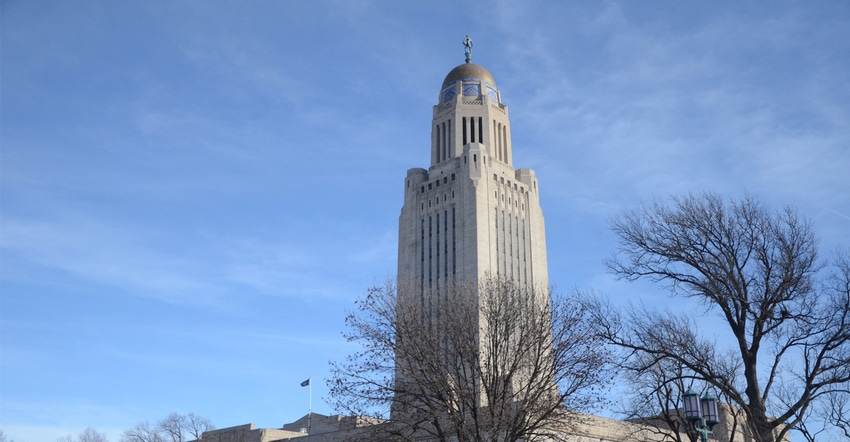
For farmers, ranchers and ag landowners in Nebraska, 2020 hasn't been all bad. For the past several years, the Nebraska Unicameral Legislature wrapped up without passing any kind of property tax relief. However, this summer, the Legislature voted 41-4 to approve LB1107. Its passage has been dubbed the "great compromise" by several ag organizations.
LB1107 includes amended provisions from LB1084, which requires the state to provide $300 million in matching funds for a potential academic hospital and all-hazards disaster response facility at the University of Nebraska Medical Center; and provisions from LB720, which creates a new business tax incentive program, the ImagiNE Nebraska Act.
However, LB1107 also includes provisions that provide property tax relief for ag landowners.
Bruce Rieker, Nebraska Farm Bureau vice president of governmental relations, notes LB1107 leaves the existing property tax credit relief fund intact. This fund, which amounts to $275 million annually, results in about a 9% reduction in property taxes on agricultural property.
"It also creates a new tier of a property tax credit fund, and this new tier delivers relief through a refundable income tax credit," Rieker says. "When it's a refundable income tax credit, even if you do not have an income tax obligation to the state, you will be able to get a refund or check for a percentage of the amount of property taxes you pay for K-12 education."
Benefits of a new tier
As part of the Property Tax Incentive Act, the Legislature has allocated $125 million per year to be put into this second tier for the first five years LB1107 is implemented.
"It's estimated that the $125 million in the first five years will result in slightly less than a 6% reduction on the property taxes that ag producers pay toward K-12 education," Rieker says. "But in Year 6, the new tier goes to $375 million per year, a 200% increase. When it's in place, we estimate it will be slightly over a 15% reduction for the property taxes paid."
Rieker notes that while the existing property tax credit relief fund provides property tax relief based on property valuation, the new refundable income tax credit provides relief based on the amount of property taxes paid.
Rieker acknowledges that under the new tier, ag land in Nebraska will receive a smaller share of the overall fund — about 33% compared to 42% with the existing property tax credit relief fund — but notes the amount of property tax relief individual ag producers receive likely will be higher than what they're getting from the existing fund.
"There are a lot of people in the Legislature that felt it was a fairer representation," he says. "If you're a person in a low-levy school district, you're not paying as much for your school as someone in a high-levy district, but you could have the same valuations."
Under LB1107, the amount of relief in the existing property tax credit relief fund can grow up to an additional $125 million per year, but not to exceed $375 million over the first five years. Any general fund revenue that exceeds 3.5% growth over the previous year's revenue is split 50-50 between the new tier of property tax relief and the cash reserve until it reaches $500 million.
"Only time will tell how much that will be available with revenue growth and how the economy recovers after COVID-19," Rieker says. "Once it reaches Year 6, when we're at $375 million, that number can grow based upon the state's average annual growth of valuations — whatever the real property valuation growth is, year over year, that $375 million can grow by that amount, not to exceed 5% growth in any one year."
Great compromise
Why was LB1107 dubbed the "great compromise"? According to Rieker, one of the biggest compromises regarding property taxes was LB1107 provided relief, rather than reform.
In the 2020 session, several bills stalled that focused on reforming how property taxes fund K-12 education. An amendment to LB1106, prepared by some members of the Revenue Committee, would have reduced property valuations for school tax purposes over three years, reducing the amount of property taxes they collect while increasing state aid to schools.
Another bill, LB183, introduced by Sen. Tom Briese and carried over from last year's session, would have changed how ag land is valued for school bond issues. Both proposals stalled before they could be brought to a vote or included in LB1107.
However, LB1107 focused on property tax relief, which Rieker says avoided enough political opposition to help advance the bill to final round before being passed.
"Sometimes success comes when 1,000 hours of preparation meet a moment of opportunity," Rieker says. "There was a moment of opportunity when Speaker [Jim] Scheer brought together six or seven senators that became the 'Gang of 7' that started working on a compromise. Sometimes people have to agree that if they get 70% or 80% of what they want in a compromise and others will probably get the same, maybe that's the sweet spot to put together a deal."
About the Author(s)
You May Also Like






